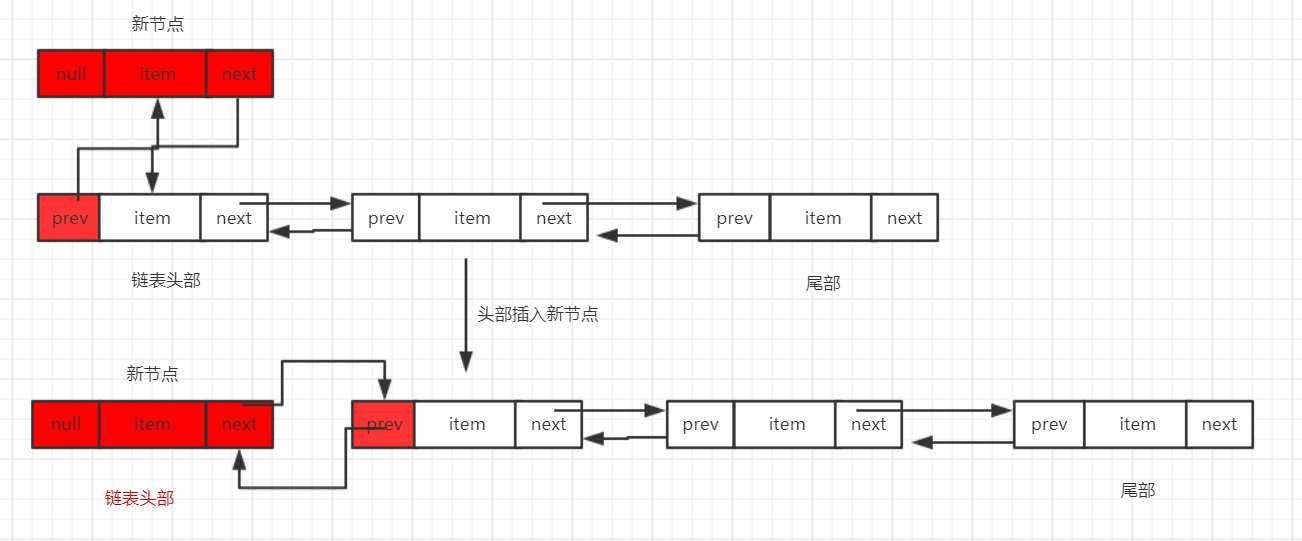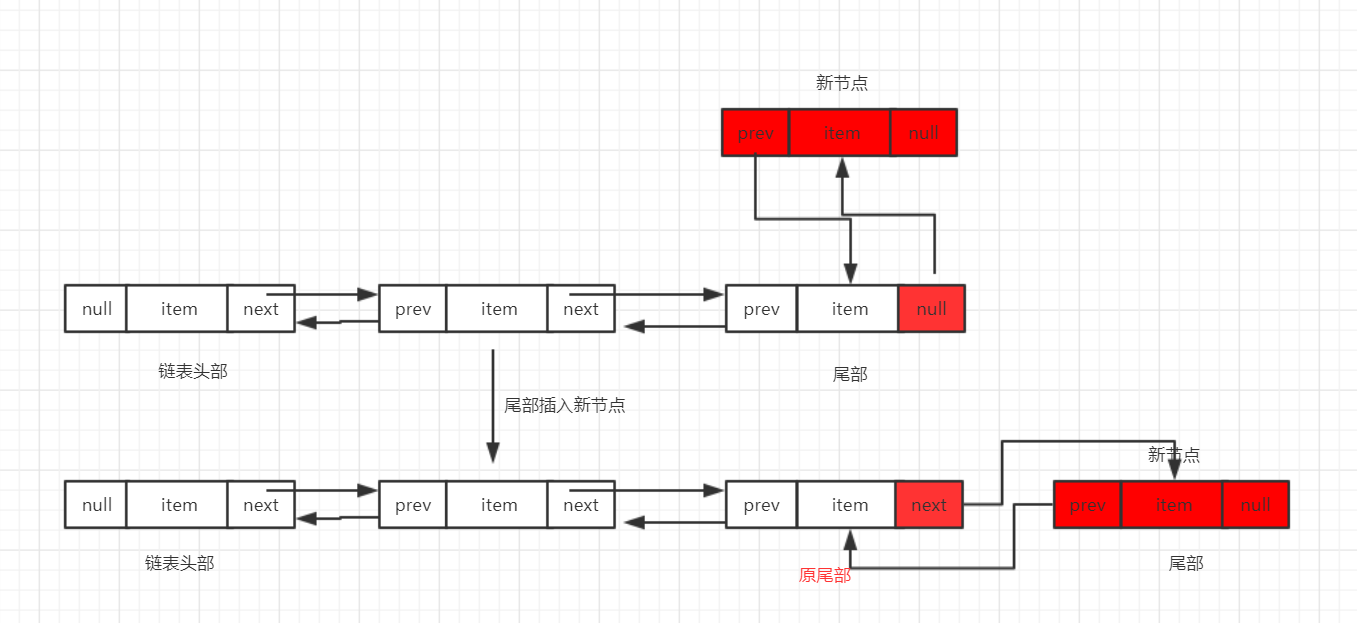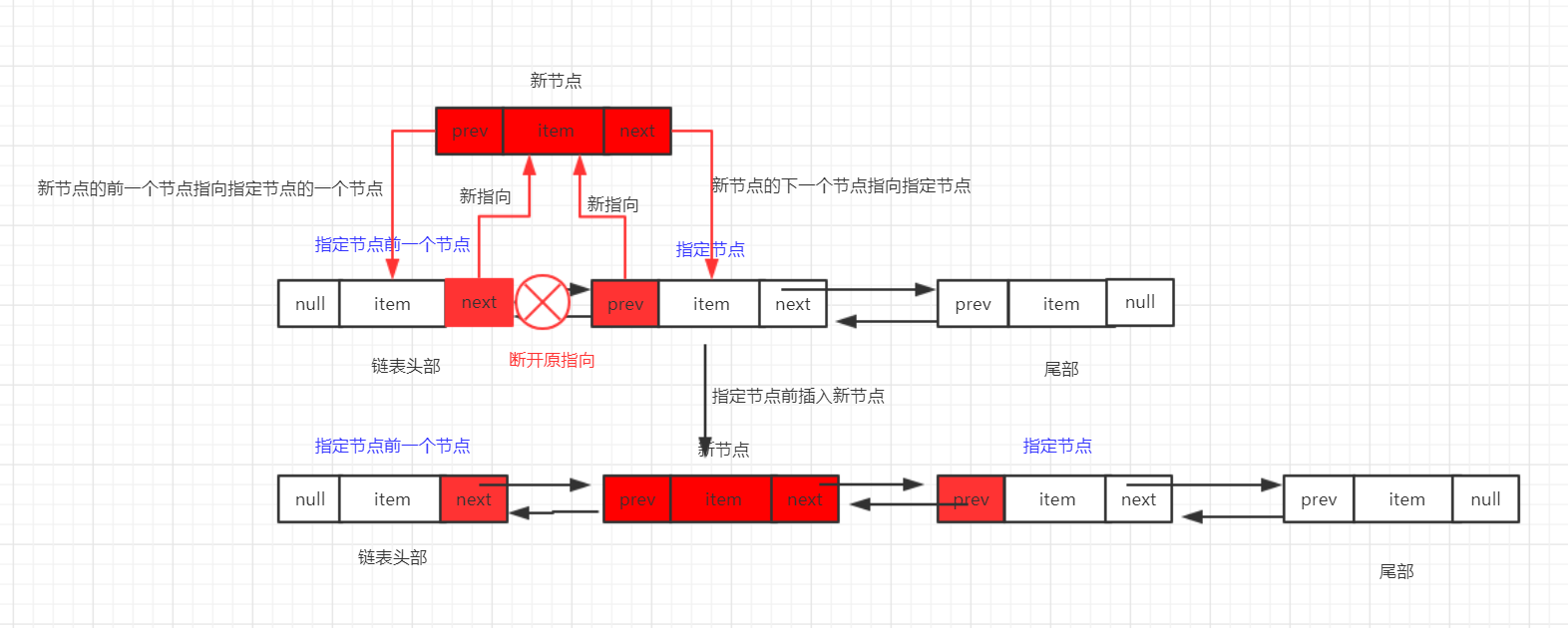jdk源码阅读笔记-LinkedList
一、LinkedList概述
LinkedList的底层数据结构为双向链表结构,与ArrayList相同的是LinkedList也可以存储相同或null的元素。相对于ArrayList来说,LinkedList的插入与删除的速度更快,时间复杂度为O(1),查找的速度就相对比较慢了,因为每次遍历的时候都必须从链表的头部或者链表的尾部开始遍历,时间复杂度为O(n/2)。为了实现快速插入或删除数据,LinkedList在每个节点都维护了一个前继节点和一个后续节点,这是一种典型的以时间换空间的思想。LinkedList同时也可以实现栈与队列的功能。
二、LinkedList的结构图

在LinkedList中每个节点有会有两个指针,一个指向前一个节点,另一个指向下一个节点。链表的头部的前指针为null,尾部的后指针也为null,因此也可以说明LinkedList(基于jdk1.8)是非循环双向链表结构。源码如下:
private static class Node<E> { E item; Node<E> next; Node<E> prev; Node(Node<E> prev, E element, Node<E> next) { this.item = element; this.next = next; this.prev = prev; } }
这是一个私有静态内部类
三、LinkedList属性
1、size: 链表的长度
2、first:链表的第一个节点
3、last:链表的最后一个节点
transient int size = 0; /** * Pointer to first node. * Invariant: (first == null && last == null) || * (first.prev == null && first.item != null) */ transient Node<E> first; /** * Pointer to last node. * Invariant: (first == null && last == null) || * (last.next == null && last.item != null) */ transient Node<E> last; /** * Constructs an empty list. */
四、添加节点
1、链表头部添加新节点
/** * Links e as first element. * 链接头部 */ private void linkFirst(E e) { //链表的第一个节点 final Node<E> f = first; //创建节点 final Node<E> newNode = new Node<>(null, e, f); //将新创建的节点放到链条头部 first = newNode; //当链表为null时,链表头部和尾部都指向新节点 if (f == null) last = newNode; else f.prev = newNode;//把原本第一个节点的前一个节点指向新的节点 size++;//链表长度加1 modCount++;//链表修改次数加1 }
当链表为空的时候比较简单,直接将链表的头部和尾部都指向新节点即可,下面我来说一下在非空的情况下头部插入新节点:

2、往链表尾部插入新节点
/** * Links e as last element. */ void linkLast(E e) { //原来的最后一个节点 final Node<E> l = last; //创建新的节点,next为null final Node<E> newNode = new Node<>(l, e, null); //将新节点指向最后一个节点 last = newNode; if (l == null) first = newNode;//链表为空时第一个节点也指向新节点 else l.next = newNode;//将原最后一个节点的next指针指向新节点 size++; modCount++; }
具体流程:

3、在指定节点之前插入新节点
/** * Inserts element e before non-null Node succ. * 指定节点之前插入新节点 */ void linkBefore(E e, Node<E> succ) { // assert succ != null; //指定的节点的前一个节点 final Node<E> pred = succ.prev; //待插入的新节点,新节点的前一个节点为 指定节点的前一个节点,下一个节点为指定节点 final Node<E> newNode = new Node<>(pred, e, succ); //指定节点的前一个节点指向新节点 succ.prev = newNode; if (pred == null) first = newNode;//如果指定节点为第一个节点,那么将节点设置为头部 else pred.next = newNode;//否则将前一个的下一个节点指向新节点 size++; modCount++; }
流程:

五、删除节点
1、删除第一个节点
/** * Unlinks non-null first node f. * 删除第一个节点 */ private E unlinkFirst(Node<E> f) { // assert f == first && f != null; //第一个节点 final E element = f.item; //第一个节点的前一个节点 final Node<E> next = f.next; //将前一个节点和原第一个节点掷为空,方便回收 f.item = null; f.next = null; // help GC //把原第一个节点设置成第一个节点 first = next; //链表只有一个节点的情况 if (next == null) last = null; else next.prev = null;//将原节点的下一个的前一个节点设置为null,因为该节点已经设置为第一个节点,而第一个节点的前一个节点为null size--; modCount++; return element; }
流程:

2、删除链表最后一个节点
/** * Unlinks non-null last node l. * 删除最后一个节点 */ private E unlinkLast(Node<E> l) { // assert l == last && l != null; //最后一个节点 final E element = l.item; //最后一个节点的前一个节点 final Node<E> prev = l.prev; l.item = null; l.prev = null; // help GC last = prev; //只有一个节点的情况 if (prev == null) first = null; else prev.next = null;//将前一个节点的下一个节点掷为null size--; modCount++; return element; }
流程:

3、删除指定节点
/** * Unlinks non-null node x. * 删除指定节点 */ E unlink(Node<E> x) { // assert x != null; //指定节点的数据 final E element = x.item; //指定节点的下一个节点 final Node<E> next = x.next; //指定节点的前一个节点 final Node<E> prev = x.prev; //指定节点为第一个节点,将下一个节点设置为第一个节点 if (prev == null) { first = next; } else {//否则,将指定节点的前一个节点指向指定节点的下一个节点 prev.next = next; x.prev = null; } //指定节点为最后一个节点,将前一个节点设置为最后一个节点 if (next == null) { last = prev; } else {//否则, next.prev = prev; x.next = null; } x.item = null; size--; modCount++; return element; }
流程:

六、添加数据
1、add方法:
/** * Appends the specified element to the end of this list. * * <p>This method is equivalent to {@link #addLast}. * * @param e element to be appended to this list * @return {@code true} (as specified by {@link Collection#add}) */ public boolean add(E e) { //向链表的最后位置插入一个节点 linkLast(e); return true; }
2、addFirst方法:
/** * Inserts the specified element at the beginning of this list. * * @param e the element to add */ public void addFirst(E e) { linkFirst(e); }
具体的插入流程可参照第4部分;
3、addLast方法:
/** * Appends the specified element to the end of this list. * * <p>This method is equivalent to {@link #add}. * * @param e the element to add */ public void addLast(E e) { linkLast(e); }
具体流程参照第四部分的linkLast方法解释;
七、获取数据
获取数据也是分为3个方法,获取链表头部的节点数据,尾部节点数据和其他的节点数据。获取头部和尾部比简单,直接获取first节点或last节点就可以了,这里我们主要看一下是怎么获取其他的节点:
/** * Returns the element at the specified position in this list. * * @param index index of the element to return * @return the element at the specified position in this list * @throws IndexOutOfBoundsException {@inheritDoc} */ public E get(int index) { checkElementIndex(index); return node(index).item; }
从源码中可以看到,获取其他节点的数据时,是根据下标来获取的,首先先检查输入的index下标是否有越界的嫌疑,然后node方法,下面我们看一下node方法具体实现方式:
/** * Returns the (non-null) Node at the specified element index. */ Node<E> node(int index) { // assert isElementIndex(index); /** * 传入的index如果大于链表长度的一半,那个从链表后面向前遍历 * 否则,从前面开始遍历 */ if (index < (size >> 1)) { Node<E> x = first; for (int i = 0; i < index; i++) x = x.next; return x; } else { Node<E> x = last; for (int i = size - 1; i > index; i--) x = x.prev; return x; } }
从代码中可以看到,如果使用get(index)方法时,每一次都需要从头部或尾部开始遍历,效率比较低。如果要遍历LinkedList,也不推荐这种方式。
八、删除数据
删除数据也是3中方法,只讲删除其他节点数据的方法:
/** * Removes the first occurrence of the specified element from this list, * if it is present. If this list does not contain the element, it is * unchanged. More formally, removes the element with the lowest index * {@code i} such that * <tt>(o==null ? get(i)==null : o.equals(get(i)))</tt> * (if such an element exists). Returns {@code true} if this list * contained the specified element (or equivalently, if this list * changed as a result of the call). * * @param o element to be removed from this list, if present * @return {@code true} if this list contained the specified element */ public boolean remove(Object o) { if (o == null) {//为null的情况,从头部开始查找 for (Node<E> x = first; x != null; x = x.next) { if (x.item == null) { unlink(x); return true; } } } else {//非null,从头部开始查找,然后删除掉 for (Node<E> x = first; x != null; x = x.next) { if (o.equals(x.item)) { unlink(x); return true; } } } return false; }
从源码中可以看到,在删除元素的时候是从第一个节点开始一个一个遍历,通过equals方法的来获取到需要删除节点,然后调用unlinke方法将节点删除掉的。
九、实现stack相关方法
栈的数据结构实现了FIFO的顺序,即先进先出的规则。
1、push方法:
/** * Pushes an element onto the stack represented by this list. In other * words, inserts the element at the front of this list. * * <p>This method is equivalent to {@link #addFirst}. * * @param e the element to push * @since 1.6 */ public void push(E e) { addFirst(e); }
每次添加数据的时候都是添加到链表头部。
2、pop方法:
/** * Pops an element from the stack represented by this list. In other * words, removes and returns the first element of this list. * * <p>This method is equivalent to {@link #removeFirst()}. * * @return the element at the front of this list (which is the top * of the stack represented by this list) * @throws NoSuchElementException if this list is empty * @since 1.6 */ public E pop() { return removeFirst(); }
往栈中获取一个数据,同时也将栈的第一个数据删除。
3、peek方法:
/** * Retrieves, but does not remove, the head (first element) of this list. * * @return the head of this list, or {@code null} if this list is empty * @since 1.5 */ public E peek() { final Node<E> f = first; return (f == null) ? null : f.item; }
查看栈中的第一个数据,跟pop方法的区别是peek方法只是查看数据,并没有删除数据,pop是从栈中弹出一个数据,需要从栈中删除数据。
十、实现queue方法
队列也是我们在开发的过程经常使用到数据结构,比如消息队列等,队列的特点是每次添加数据的时候都是添加大队列的尾部,获取数据时总是从头部拉取。基于以上特点,我们可以使用LinkedList中的linkLast方式实现数据的添加,使用unLinkfirst方法实现数据的拉取,使用getFisrt方法实现数据的查看,源码如下:
1、添加数据:
/** * Adds the specified element as the tail (last element) of this list. * * @param e the element to add * @return {@code true} (as specified by {@link Queue#offer}) * @since 1.5 */ public boolean offer(E e) { return add(e); }
2、拉取数据:
/** * Retrieves and removes the head (first element) of this list. * * @return the head of this list, or {@code null} if this list is empty * @since 1.5 */ public E poll() { final Node<E> f = first; return (f == null) ? null : unlinkFirst(f); }
3、查看数据:
/** * Retrieves, but does not remove, the head (first element) of this list. * * @return the head of this list, or {@code null} if this list is empty * @since 1.5 */ public E peek() { final Node<E> f = first; return (f == null) ? null : f.item; }
十一、LinkedList使用注意事项
1、LinkedList是非线程安全的,在多线程的环境下可能会发生不可预知的结果,所以在多线程环境中谨慎使用它,可以转换成线程类,或是使用线程安全的集合类来代替LinkedList的使用。
2、遍历LinkedList中的数据的时候,切记别使用fori方式(即随机顺序访问get(index))去遍历,建议使用迭代器或foreach方式遍历。原因在上面的源码中也说到过,可以看一下第七部分数据获取中,使用get(index)方法获取数据时每次都是链表头部或尾部开始遍历,这样是非常不合理的,时间复杂度为O(n^2)。在数据量较小的情况下是没有什么区别,但是数据上去之后,可能会出现程序假死的现象。测试如下:
public static void main(String[] args) throws Exception { List<Integer> list = new LinkedList<>(); for (int i = 0; i < 100000; i++) { list.add(i); } long start = System.currentTimeMillis(); for (int i = 0; i < list.size(); i++) { list.get(i); } long end = System.currentTimeMillis(); System.out.println("使用fori方式所需时间:" + (end - start)); start = System.currentTimeMillis(); for (Integer integer : list) { } end = System.currentTimeMillis(); System.out.println("使用foreach方式所需时间:" + (end - start)); start = System.currentTimeMillis(); Iterator<Integer> iterator = list.iterator(); while (iterator.hasNext()){ Integer next = iterator.next(); } end = System.currentTimeMillis(); System.out.println("使用迭代器方式所需时间:" + (end - start)); }
三种遍历10万条数据所需要时间:
使用fori方式所需时间:5288 使用foreach方式所需时间:3 使用迭代器方式所需时间:2
从结果中可以看到,使用迭代器或foreach方式比fori方式快的不是十倍百倍,原因是使用foreach和迭代器的时候每次获取数据后都记录当前的位置index,当下个循环的时候直接在index+1处获取即可,而不需要从新在头部或尾部开始遍历了。
十二、总结
1、LinkedList是非线程安全的。
2、LinkedList可以存储null值或重复的数据。
3、LinkedList底层存储结构为双向链式非循环结构,这种结构添加删除的效率高于查询效率。
4、与ArrayList相比较,LinkedList的删除添加数据效率要比ArrayList高,查询数据效率低于ArrayList。
5、LinkedList可以用于实现stack和queue数据结构,比如:Queue<T> queue = new LinkedList<T>();
6、遍历数据时切勿使用随机访问方式遍历,推荐使用foreach或迭代器遍历。
7、如果文章中有什么写得不对的地方,欢迎大家指出来。





【推荐】编程新体验,更懂你的AI,立即体验豆包MarsCode编程助手
【推荐】凌霞软件回馈社区,博客园 & 1Panel & Halo 联合会员上线
【推荐】抖音旗下AI助手豆包,你的智能百科全书,全免费不限次数
【推荐】博客园社区专享云产品让利特惠,阿里云新客6.5折上折
【推荐】轻量又高性能的 SSH 工具 IShell:AI 加持,快人一步